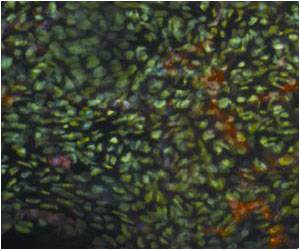A protein called Pur-alpha is a component of stress granules, and it could serve as a novel therapeutic target for developing a treatment for ALS patients.

‘Researchers identified a protein that can protect against the toxic degeneration of cells in diseases like ALS, also known as Lou Gehrig's disease.’





This built-in protection is compromised in ALS patients because disease-causing mutations in the FUS gene protein cause it to become mislocalized to the body of the cell, rather than the nucleus, where it incorporates into the stress granules. The stress granules then stall out, trapping Pur-alpha inside and unable to function. The team also found that supplying external Pur-alpha protein helps in suppressing the motor neuron degeneration associated with FUS-carrying ALS-causing mutations by promoting stalled stress granule turn-over. The study suggests that Pur-alpha could serve as a novel therapeutic target for developing a treatment for ALS patients. "We are eager to determine if we can mitigate the FUS toxicity by a cell permeable Pur-alpha peptide in motor neurons derived from induced pluripotent stem cells carrying FUS mutations," said Udai Pandey, PhD, who is an Assistant Professor Department of Pediatrics, Neurology and Human Genetics at the University of Pittsburgh Medical Center.
"Also, we are trying to identify which biological pathway(s) are regulated by Pur-alpha protein and how disease-causing mutations in FUS perturb them. Our data provide new mechanistic details of FUS-related ALS and identifies Pur-alpha as a potential therapeutic target that could help in mitigating neuronal cell death," notes LSU Health New Orleans graduate student J. Gavin Daigle. "Our findings further suggest that defective RNA-metabolism strongly contributes to ALS pathogenesis and neurodegeneration. Also, I'm excited to see how these discoveries could shed light onto the basic biological pathways linking several familial forms of ALS."
According to the National Institutes of Health, ALS is a rapidly progressive, invariably fatal neurological disease that attacks the nerve cells (neurons) responsible for controlling voluntary muscles (muscle action we are able to control, such as those in the arms, legs, and face). The disease belongs to a group of disorders known as motor neuron diseases, which are characterized by the gradual degeneration and death of motor neurons. More than 12,000 people in the U.S. have a definite diagnosis of ALS, for a prevalence of 3.9 cases per 100,000 persons in the U.S. general population, according to a report on data from the National ALS Registry.
ALS is one of the most common neuromuscular diseases worldwide, and people of all races and ethnic backgrounds are affected. ALS is more common among white males, non-Hispanics, and persons aged 60-69 years, but younger and older people also can develop the disease. Men are affected more often than women. In 90 to 95% of all ALS cases, the disease occurs apparently at random with no clearly associated risk factors. Individuals with this sporadic form of the disease do not have a family history of ALS, and their family members are not considered to be at increased risk for developing it.
Advertisement
"His contributions to this study were crucial to this story." The research was funded by grants from the National Institute of Neurological Disorders of the National Institutes of Health, the Robert Packard Center for ALS at Johns Hopkins and the Amyotrophic Lateral Sclerosis Association. Daigle will graduate from LSU Health New Orleans with a Doctor of Philosophy in Genetics in May 2016. A diploma-only student this semester, Daigle is currently a postdoctoral fellow at Johns Hopkins Medical Center where he will be continuing his research on ALS in the laboratory of Dr. Jeff Rothstein, an internationally known physician-scientist for his work on ALS.
Advertisement










